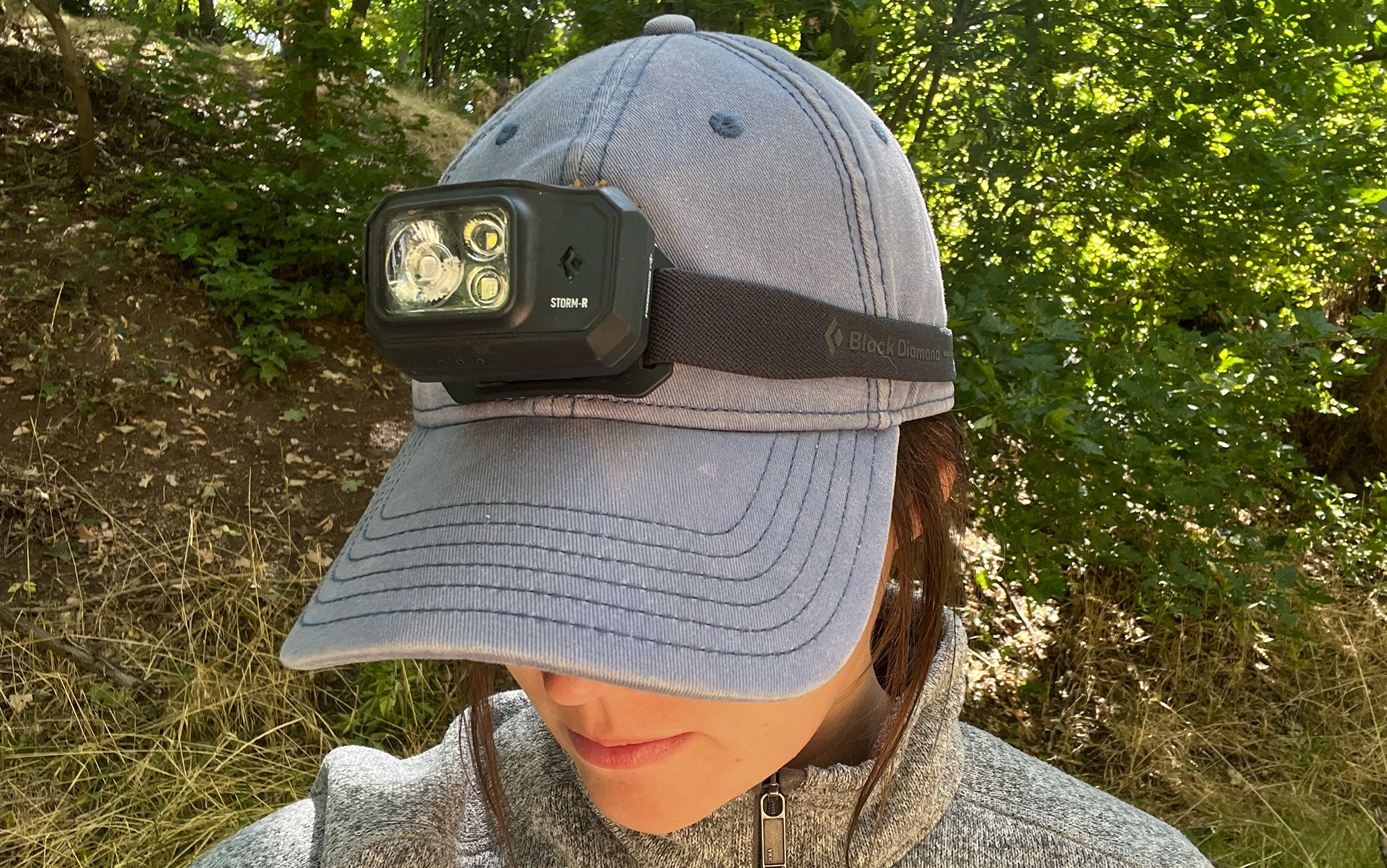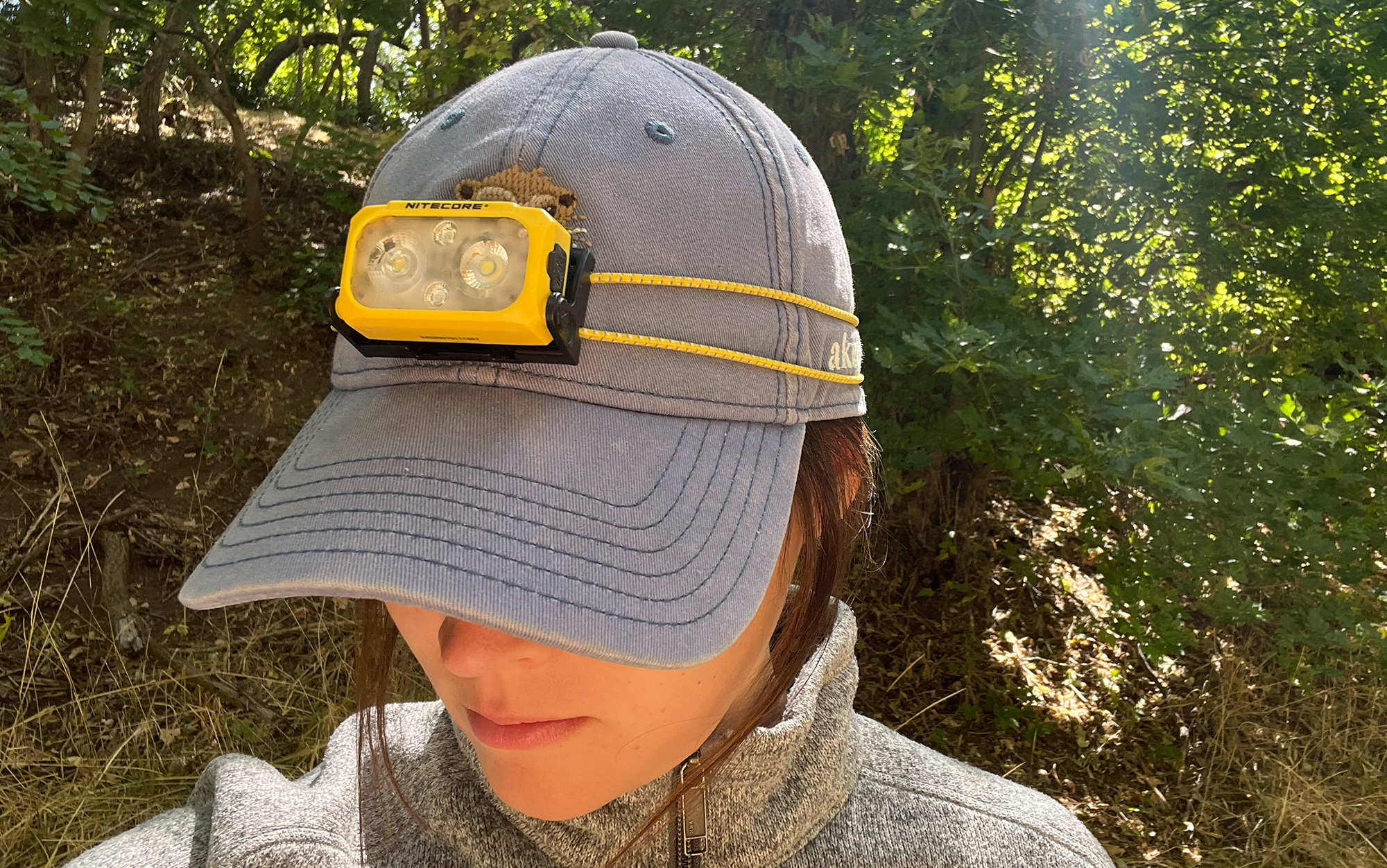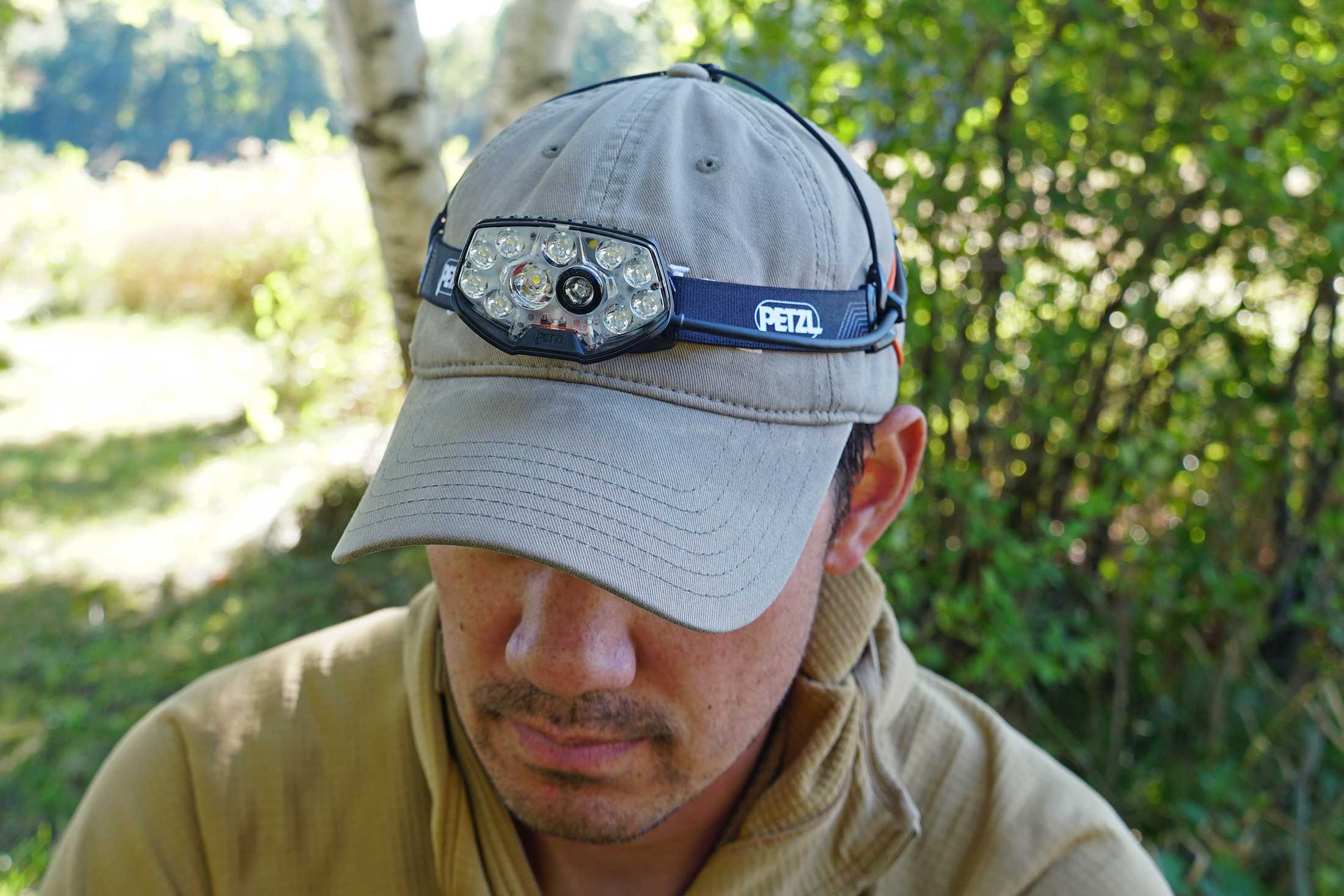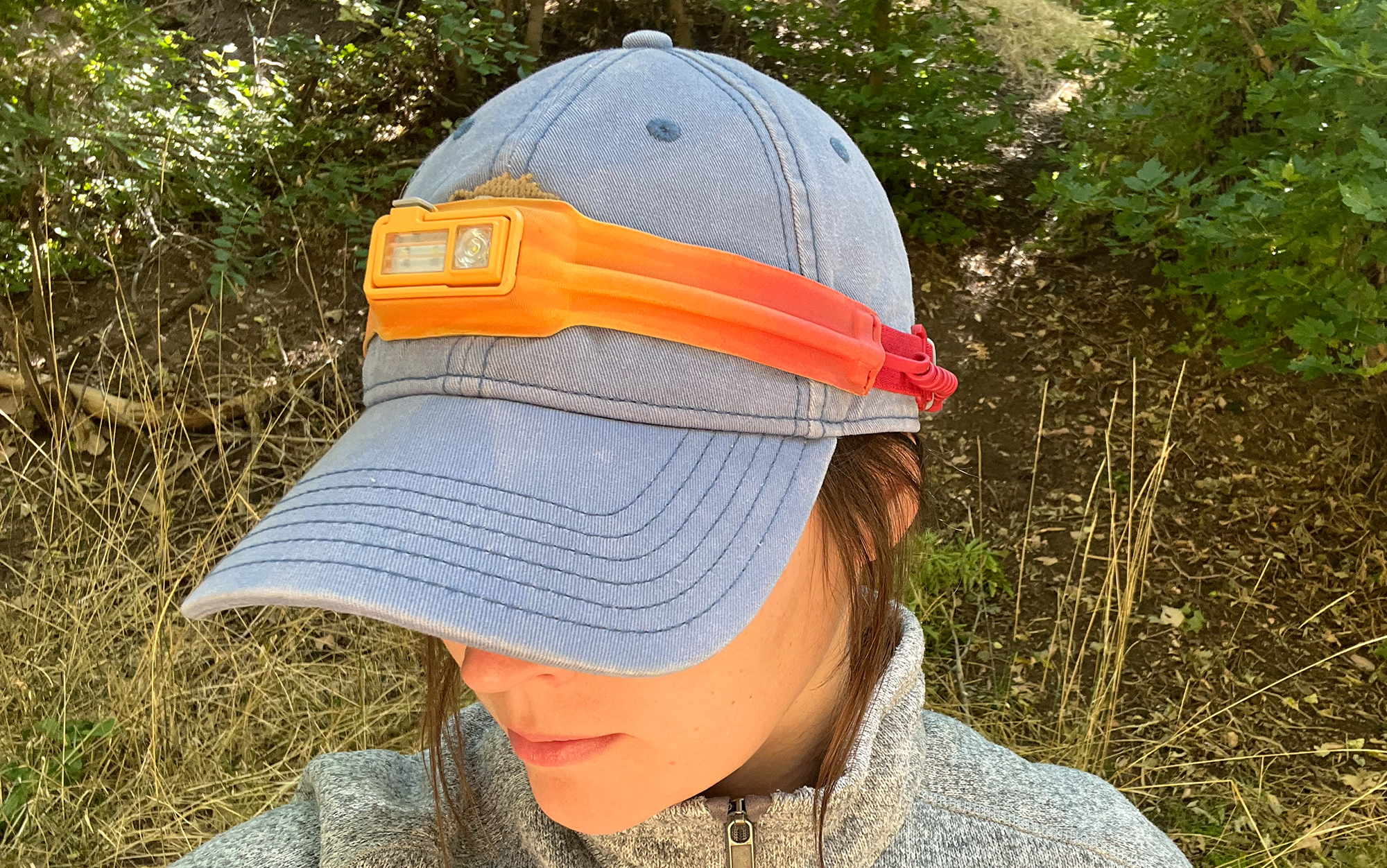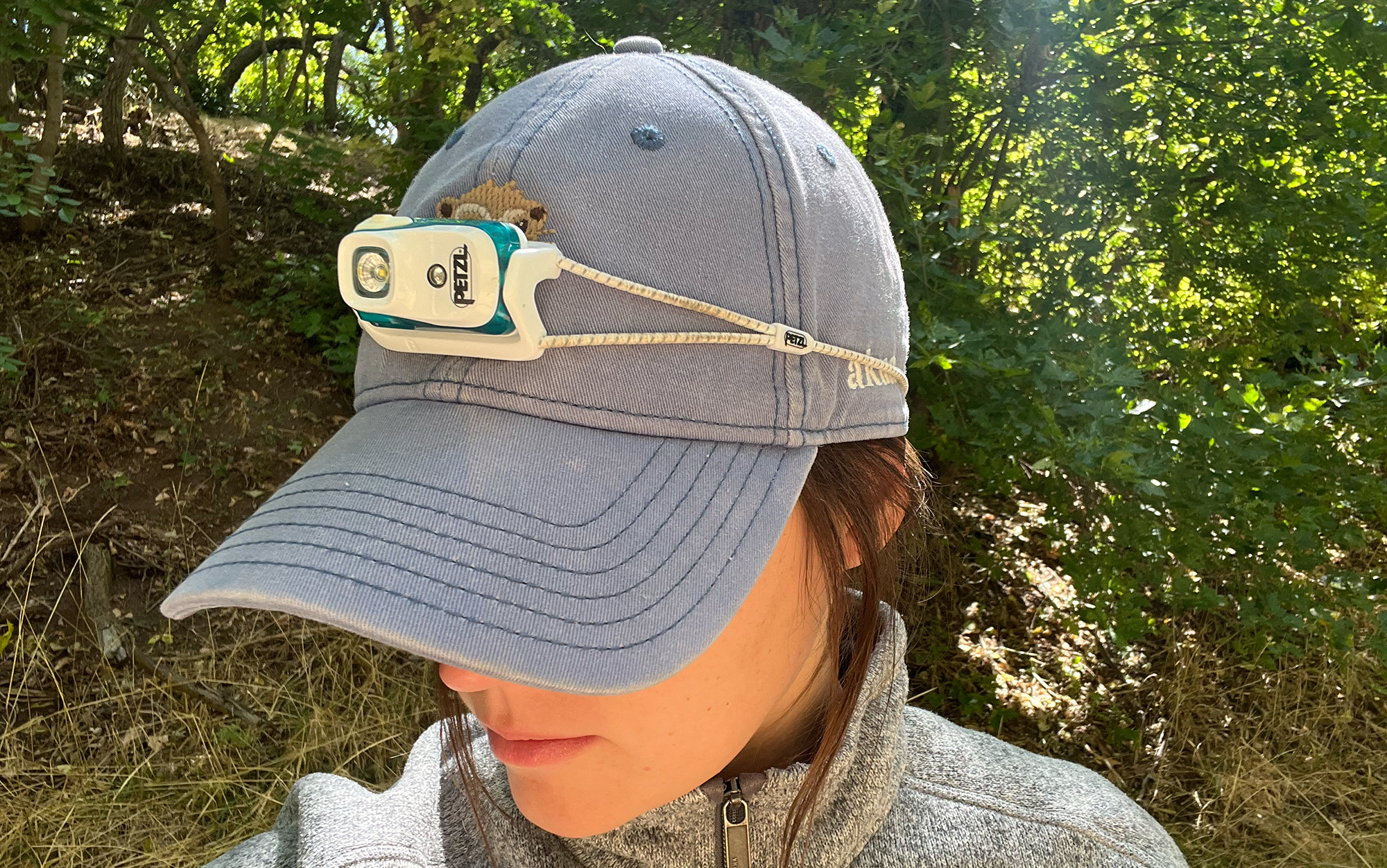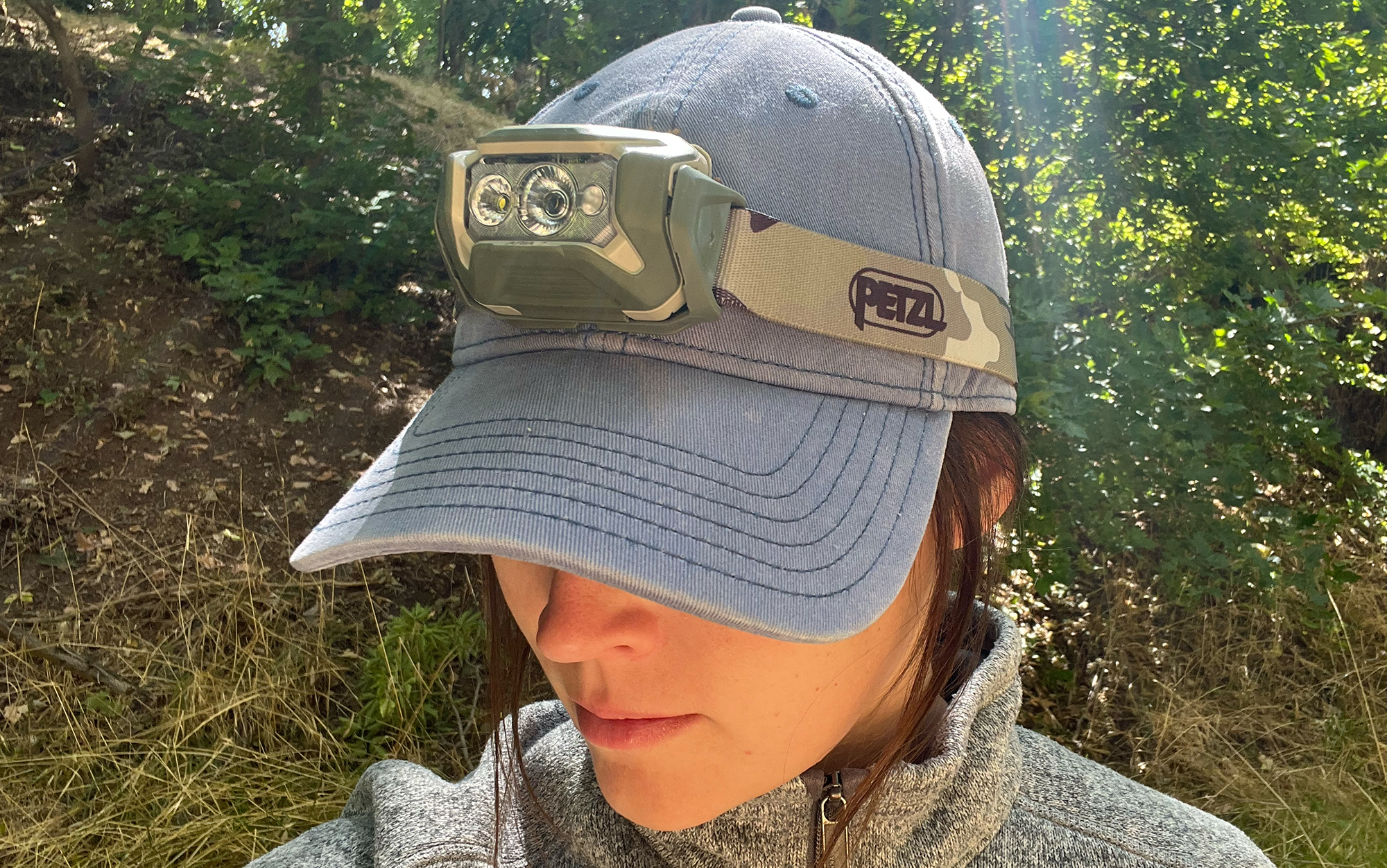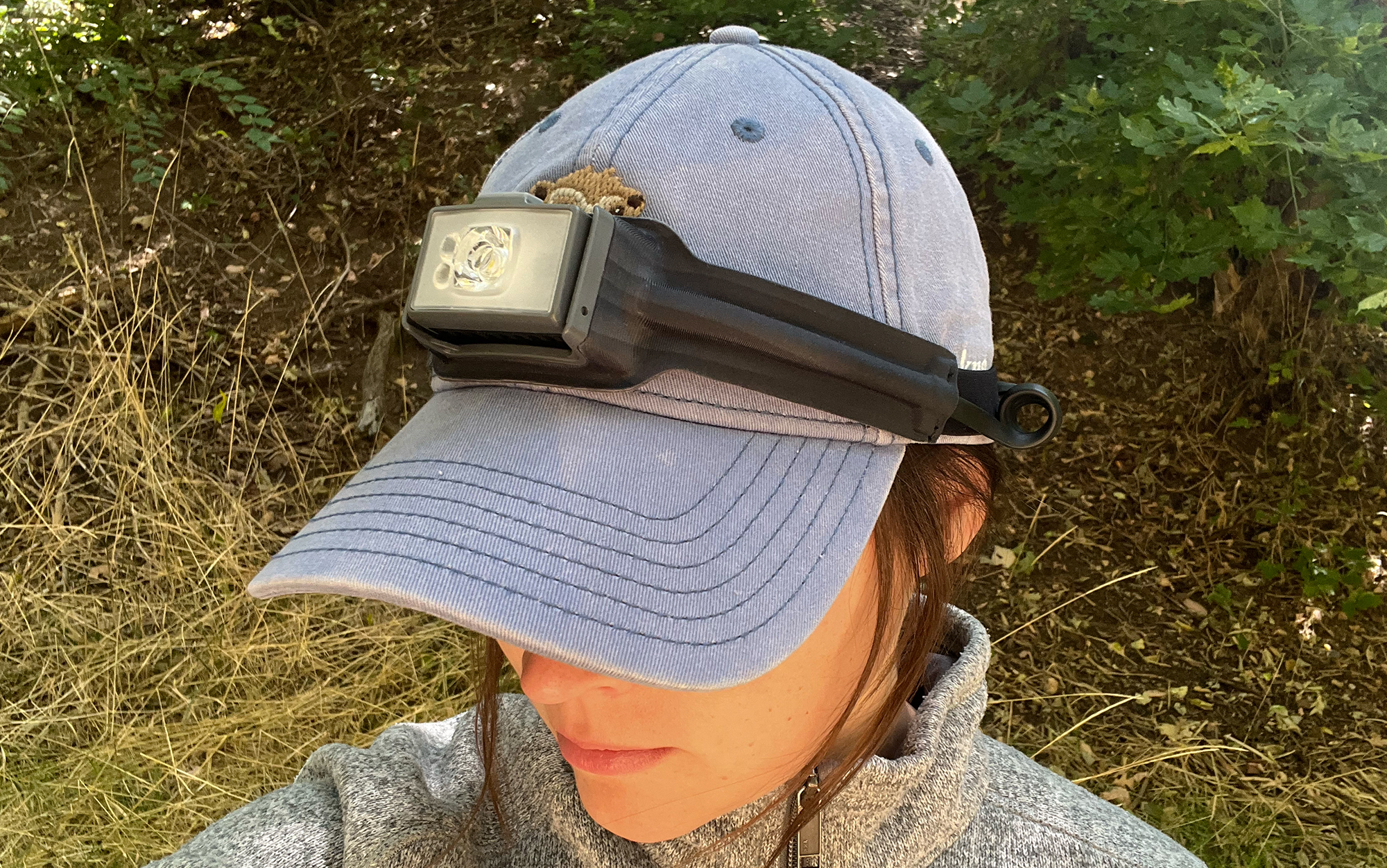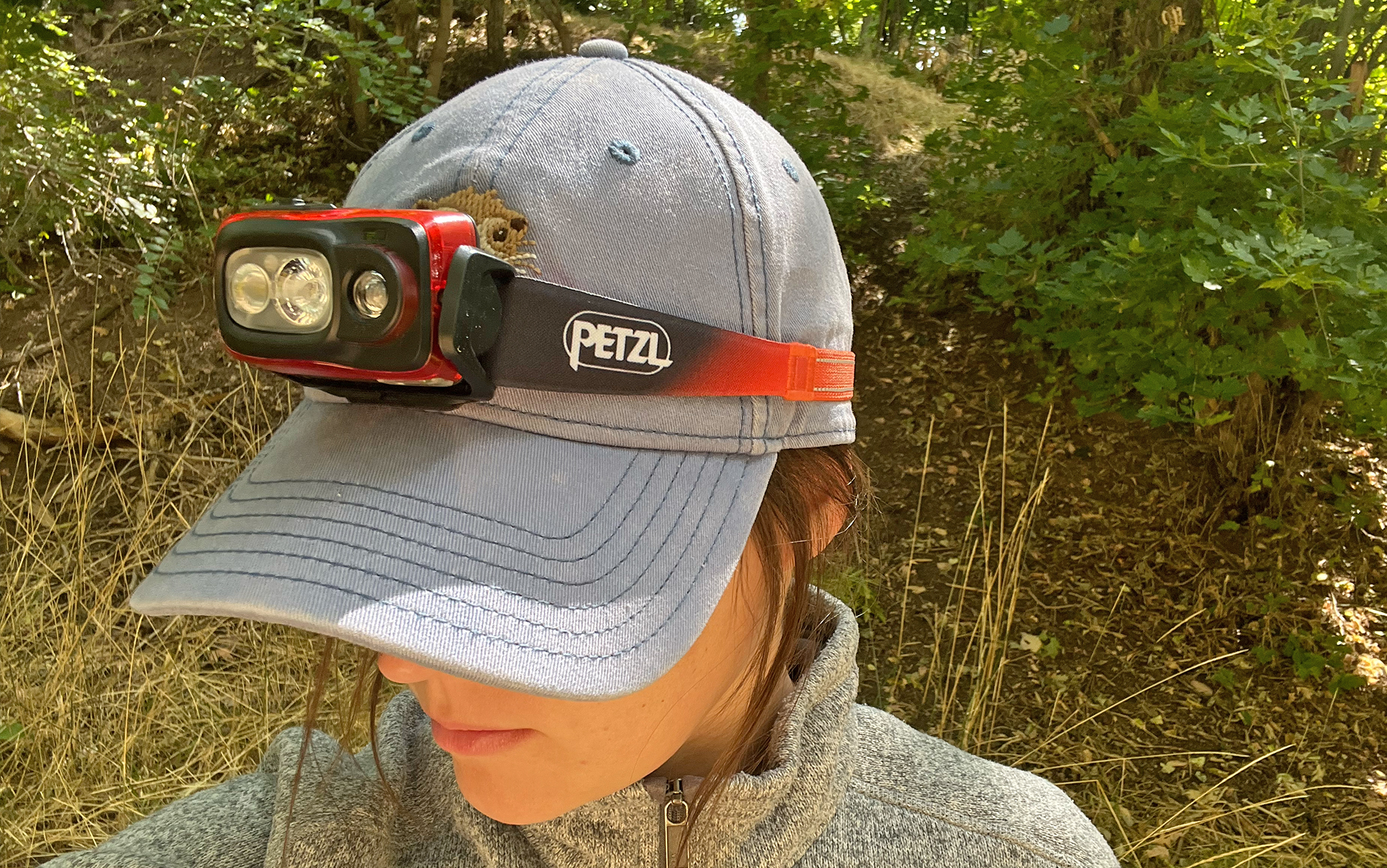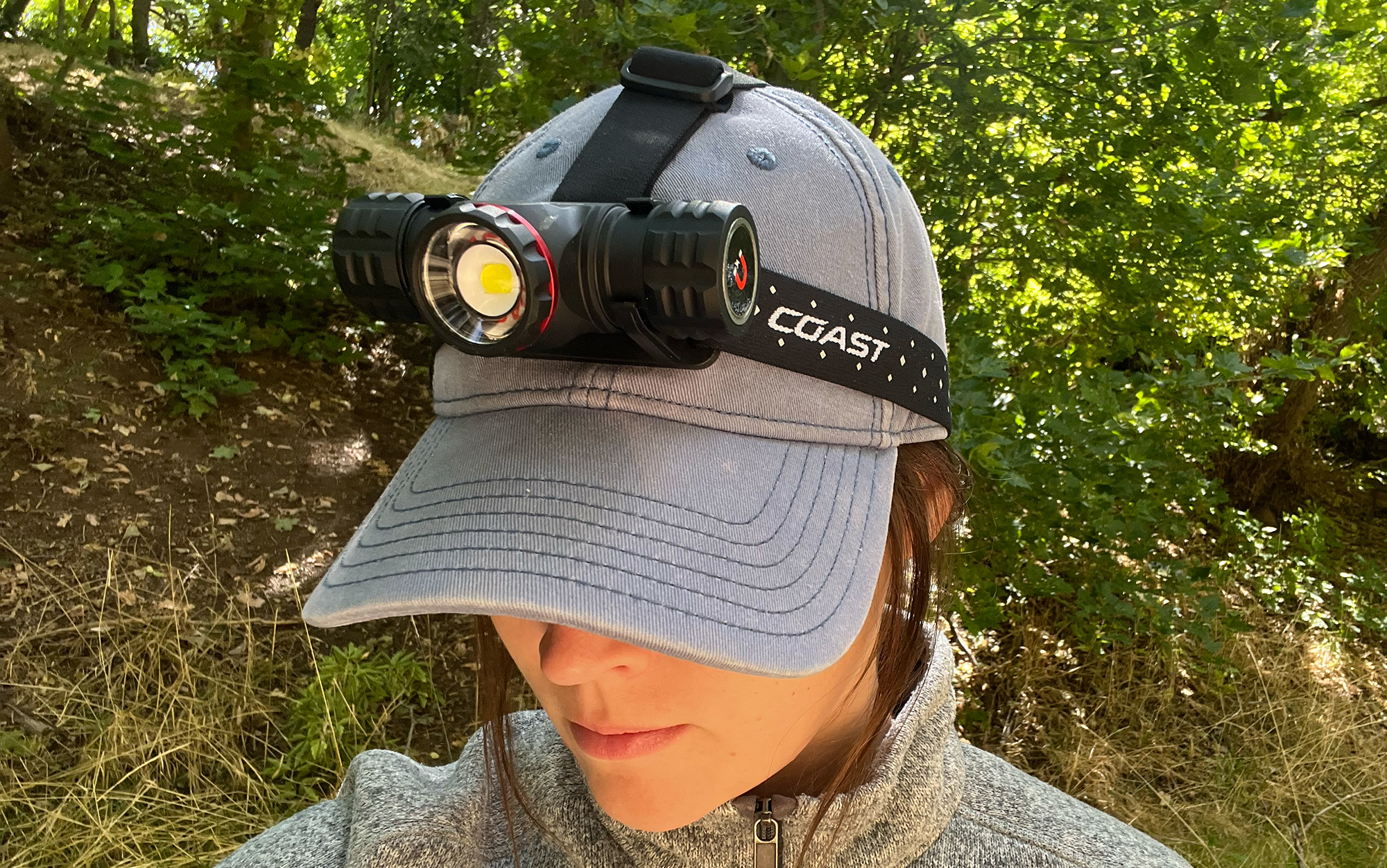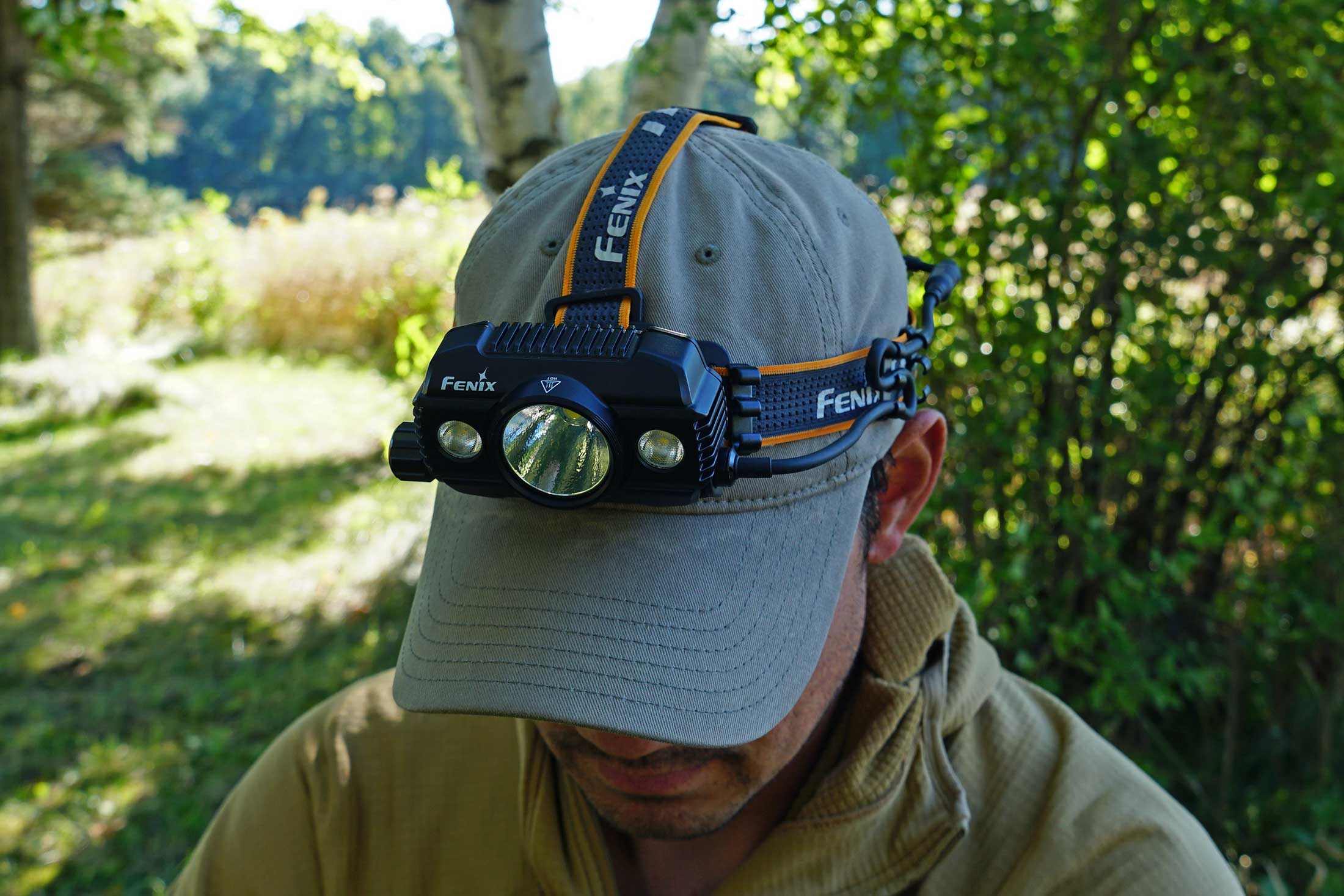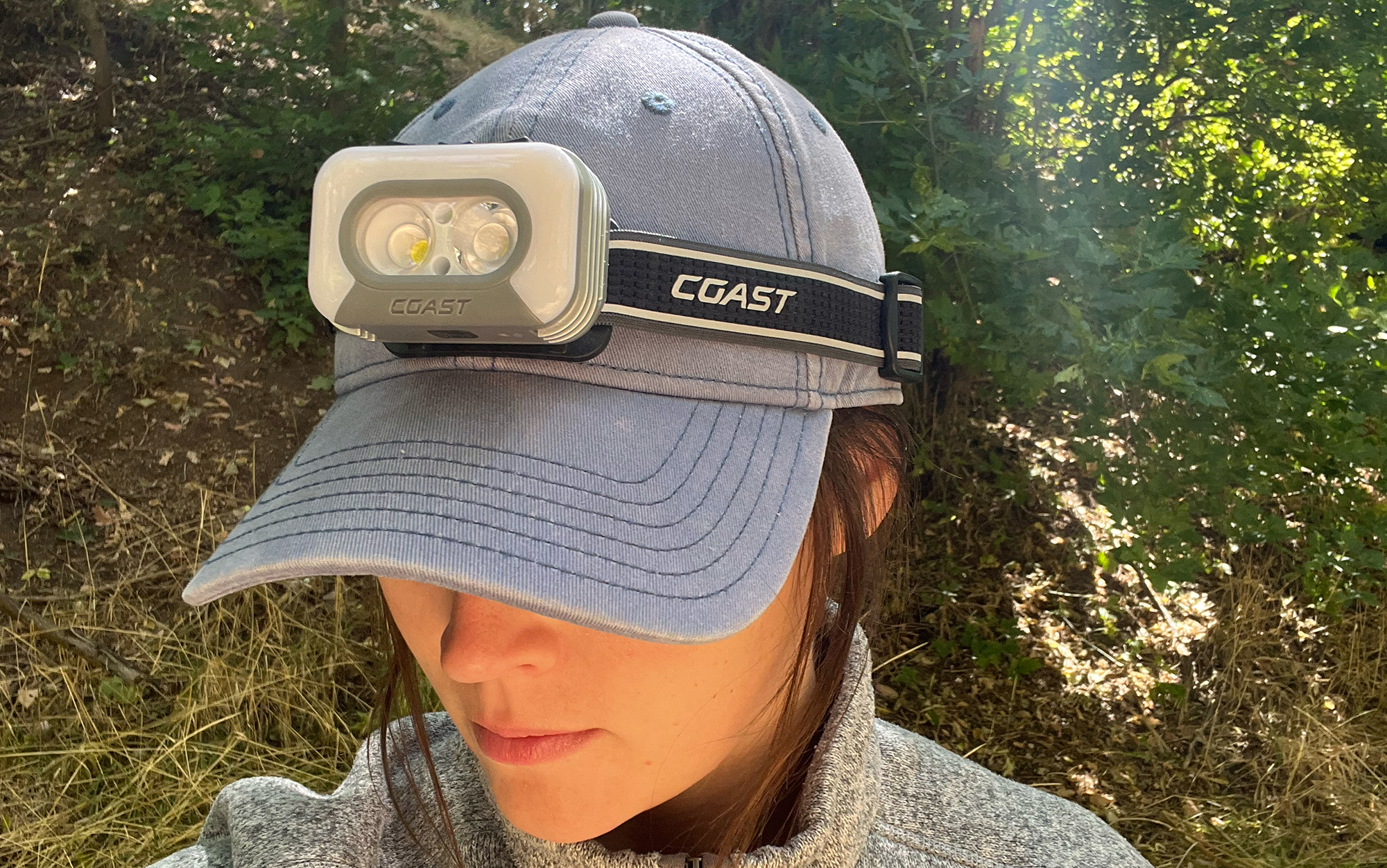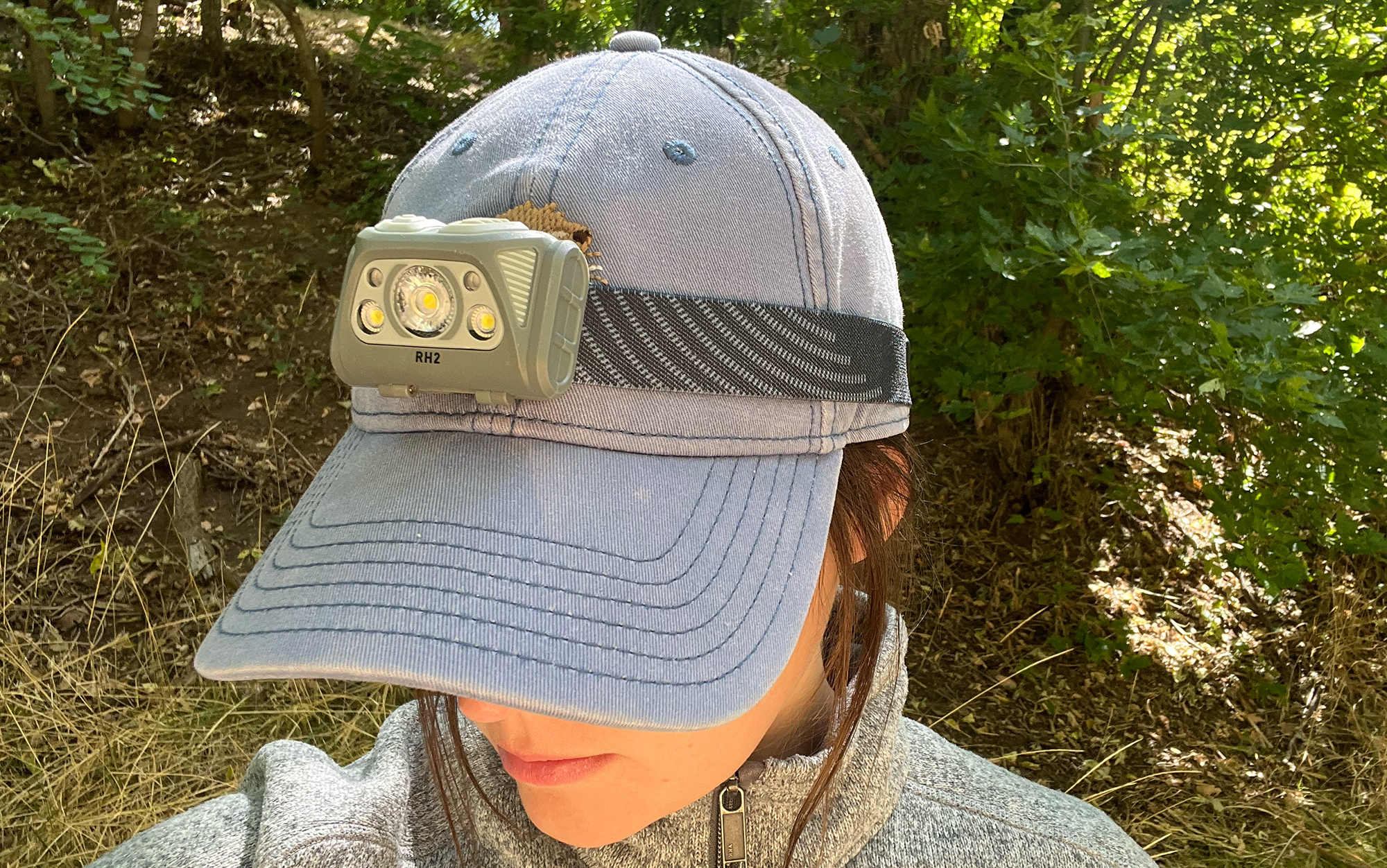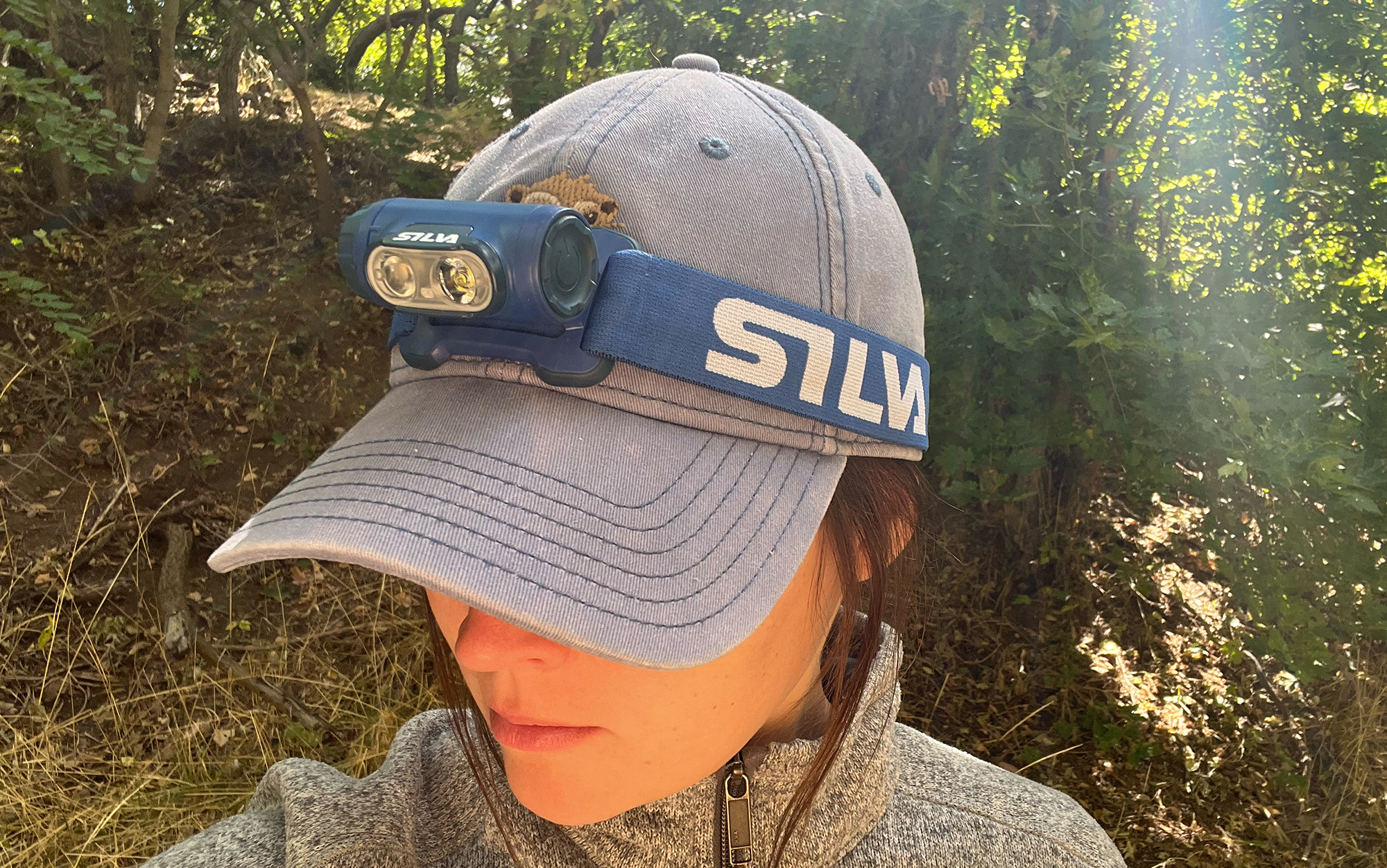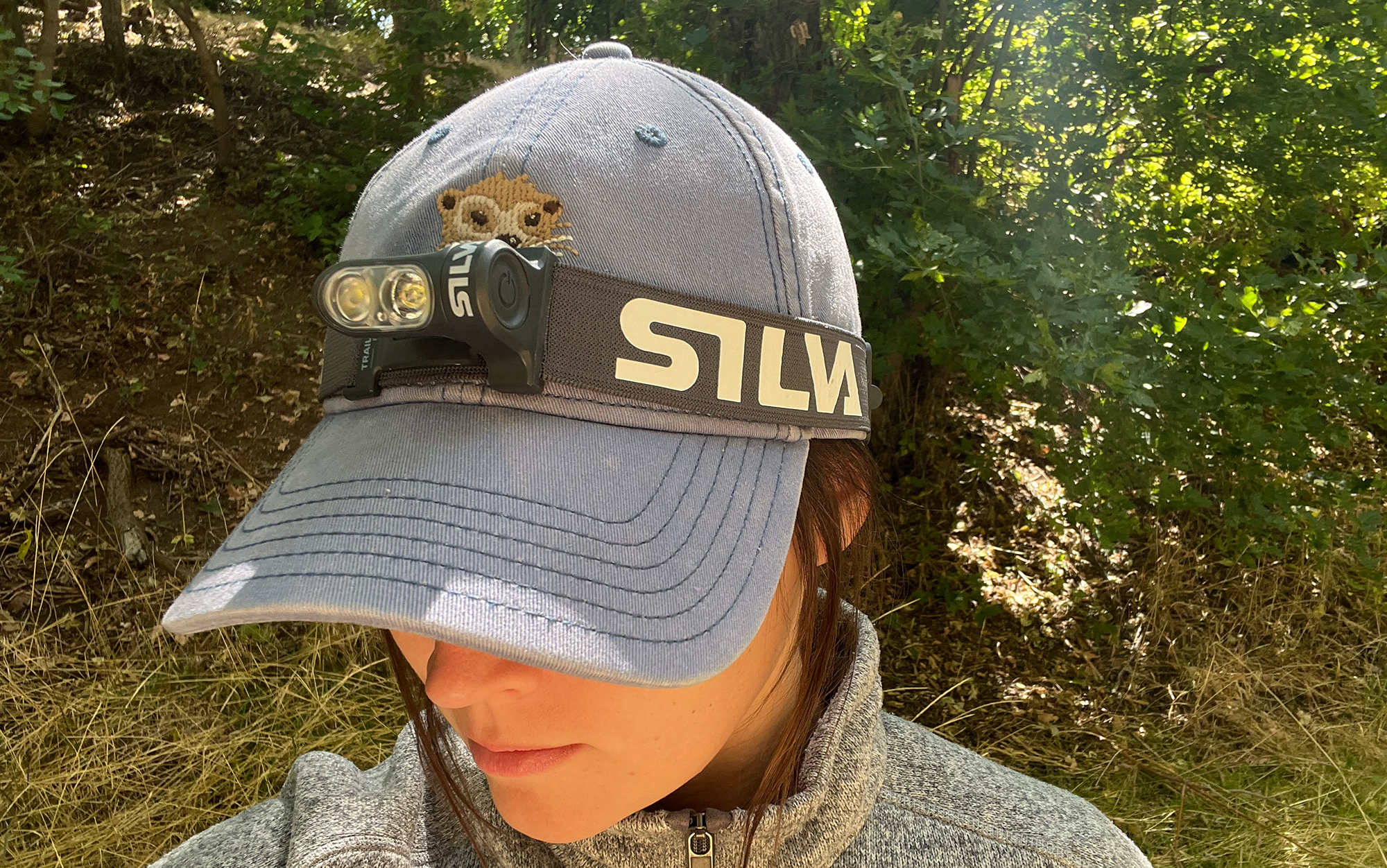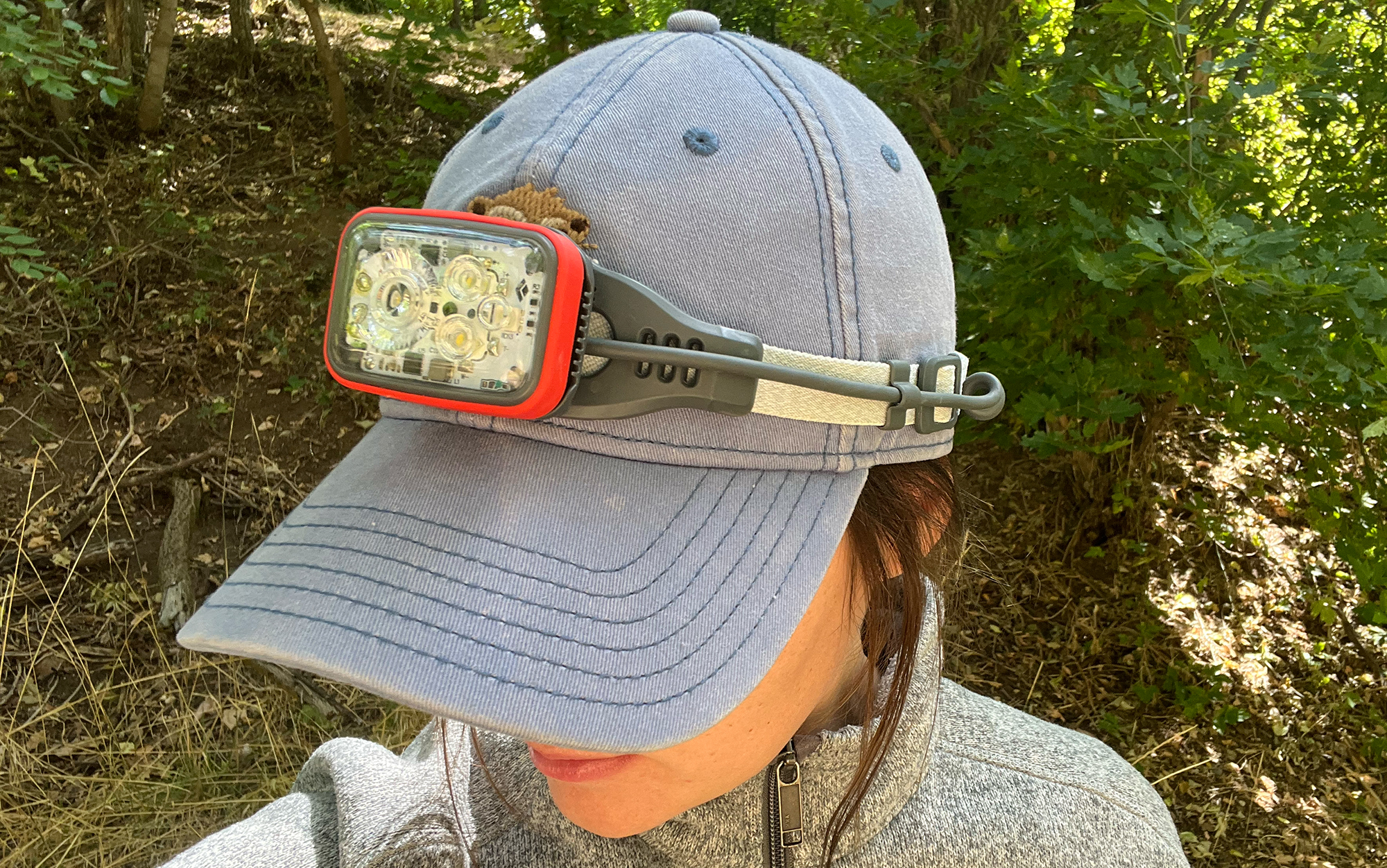The Best Headlamps of 2024, Tested and Reviewed
We may earn revenue from the products available on this page and participate in affiliate programs. Learn More ›
Headlamps are one of those unique pieces of gear that almost everyone needs: campers, hunters, hikers, climbers, backcountry skiers, and runners. Whether you’re getting up before the sun, setting up camp at night, or exploring a dark area, hands-free lighting is crucial.
While the headlamp market is oversaturated with bulky no-name models that die too quickly, if you’re relying on a headlamp to maneuver at night don’t risk your safety on something unreliable. I tested the best headlamps on the market to help you find a model with the brightness, comfort, battery life, and modes that are right for you.
- Best Overall: Black Diamond Storm R
- Best Value: Nitecore Nu25 UL
- Best for Trail Running: Petzl Nao RL
- Best for Hiking: BioLite Headlamp 425
- Most Packable: Petzl Bindi
- Best for Camping: Petzl Aria 2
- Best for Climbing: BioLite Headlamp 800 Pro
- Best for Mountaineering: Petzl Swift RL
- Best 2,000 Lumen: Coast XPH34R
- Best Bright Headlamp: Fenix HP30R V2.0
- Best Voice Control: Coast RL35R
- Nite Ize Radiant RH2
- Silva Explore 4
- Silva Trail Runner Free
- Black Diamond Distance
How We Tested the Best Headlamps
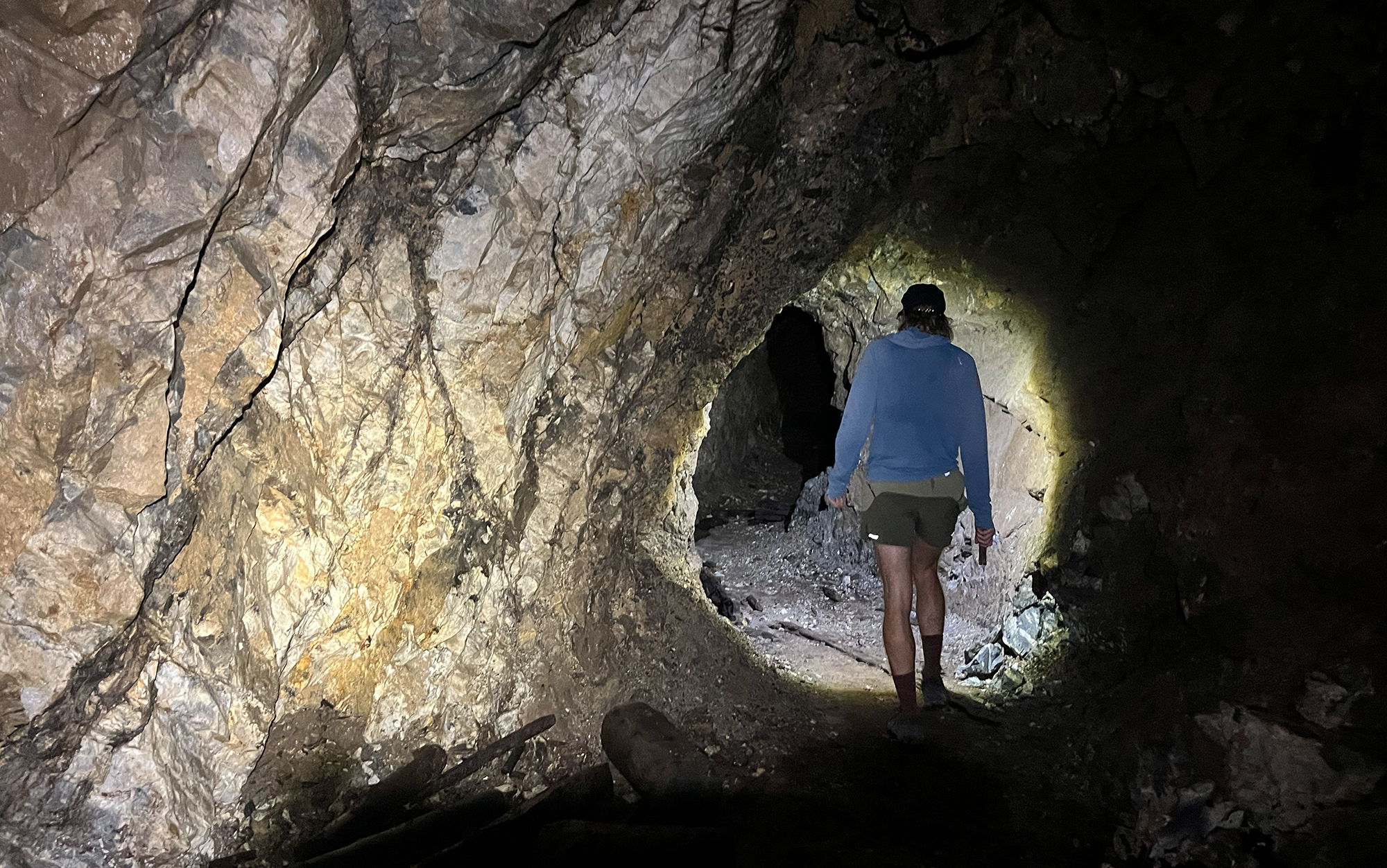
Ashley Thess
To test the best headlamps, we first used them in the field. We took compact, lightweight options on Outdoor Life’s annual backpacking gear test where eight testers used them to navigate camp at night and compare brightness side by side.
OL editor-in-chief Alex Robinson, staff writer Alice Jones Webb, and I have also been using these headlamps to run, explore, and prepare for hunting season. I took two high powered models, the Coast XPH34R and Black Diamond Distance, into a dark cave to see how they illuminated a pitch black space.
By using these headlamps in the field and doing side by side comparisons with models of similar lumen levels, we judged which lights performed best in close quarters versus long distances, and the different brightness settings. Then, we performed controlled battery life, freeze, and water resistance tests.
Read Next: Best Headlamps for Hunting
Battery Life
We turned all of these headlamps to the highest setting and recorded how long it took for them to die. This was to give a general idea of their battery usage, not necessarily to compare it to manufacturer provided specs. The advertised battery life was always less than the actual burn time, because manufacturers will stop counting once the light dims significantly, not when it actually dies. Keep in mind that headlamps with alkaline batteries will usually outperform rechargeable batteries.
Freeze
We put these headlamps in the freezer for an hour to make sure they’d all still turn on in freezing temps.
Water Resistance
Ingress Protection (IP) ratings dictate the dust and water resistance of a product. The first number is dust resistance from 0 to 6, and if the product is not rated to withstand dust there’s an X as a placeholder. The second number is water resistance ranging from 0 to 8.
While most of these headlamps can’t be submerged (IPX7), they should withstand splashes from all directions (IPX4). I left a majority of these headlamps outside in the sprinkling rain for half an hour. Then, I threw a cup of water on them for good measure.
Best Headlamps: Reviews & Recommendations
Best Overall: Black Diamond Storm R
Key Features
- Lumens: 500
- Modes: Proximity, distance, dimming, strobe, red, green, and blue
- Weight: 4.23 ounces
- Weather Resistance: IPX67
- Price: $75
- Warranty: 3 years
- Measured Battery Life: 13 hours and 15 minutes
- Rechargeable
Pros
- Very bright
- Dimmable red
- Waterproof
- Brightness memory
Cons
- Can easily accidentally max out the brightness
- Movement when running
In my search for the perfect headlamp, the Black Diamond Storm came out on top. It checks all the boxes for brightness, waterproofing, and comfort. In my burn time test it lasted over 13 hours. It also features brightness memory and PowerTap functions.
The brightness memory means it’ll turn on to whatever setting it was on when you turned it off. The Storm has red, green, or blue modes, so it’s nice to immediately return to the color you want. I also love that you can dim and brighten the red setting to preserve your night vision. This headlamp is doing almost everything right, making it great for backpacking, camping, and most other outdoor pursuits.
My issues with it are the PowerTap function and stability. If you’re holding the Storm or wearing it around your neck, it’s easy to initiate the PowerTap and accidentally max out the brightness and lower it again quickly, essentially flashbombing yourself. While hiking and walking it’s stable, but when running there is some movement.
Overall, this headlamp has all the light modes I want in an intuitive and easy to use design. It’s very bright, waterproof, and comfortable to wear. This is the headlamp I gravitate towards most often, just not for running.
Best Value: Nitecore Nu25 UL
Key Features
- Lumens: 400
- Modes: Spot, flood, and red
- Weight: 1.59 ounces
- Weather Resistance: IP66
- Price: $37
- Warranty: 2 years
- Measured Battery Life: 11 hours and 45 minutes
- Rechargable
Pros
- Ultralight
- Simple to use
- Affordable
Cons
- None
This is the best headlamp for your money. It’s under $40 and bright enough to maneuver around camp or hike a trail at night. It wouldn’t be bright enough for searching the woods or covering rough terrain, but for hiking or camping it’s just right. Plus, it weighs less than 2 ounces. The cords are easy to adjust to your head and relatively comfortable, plus you can easily wear it around your neck. It’s even pretty stable when running.
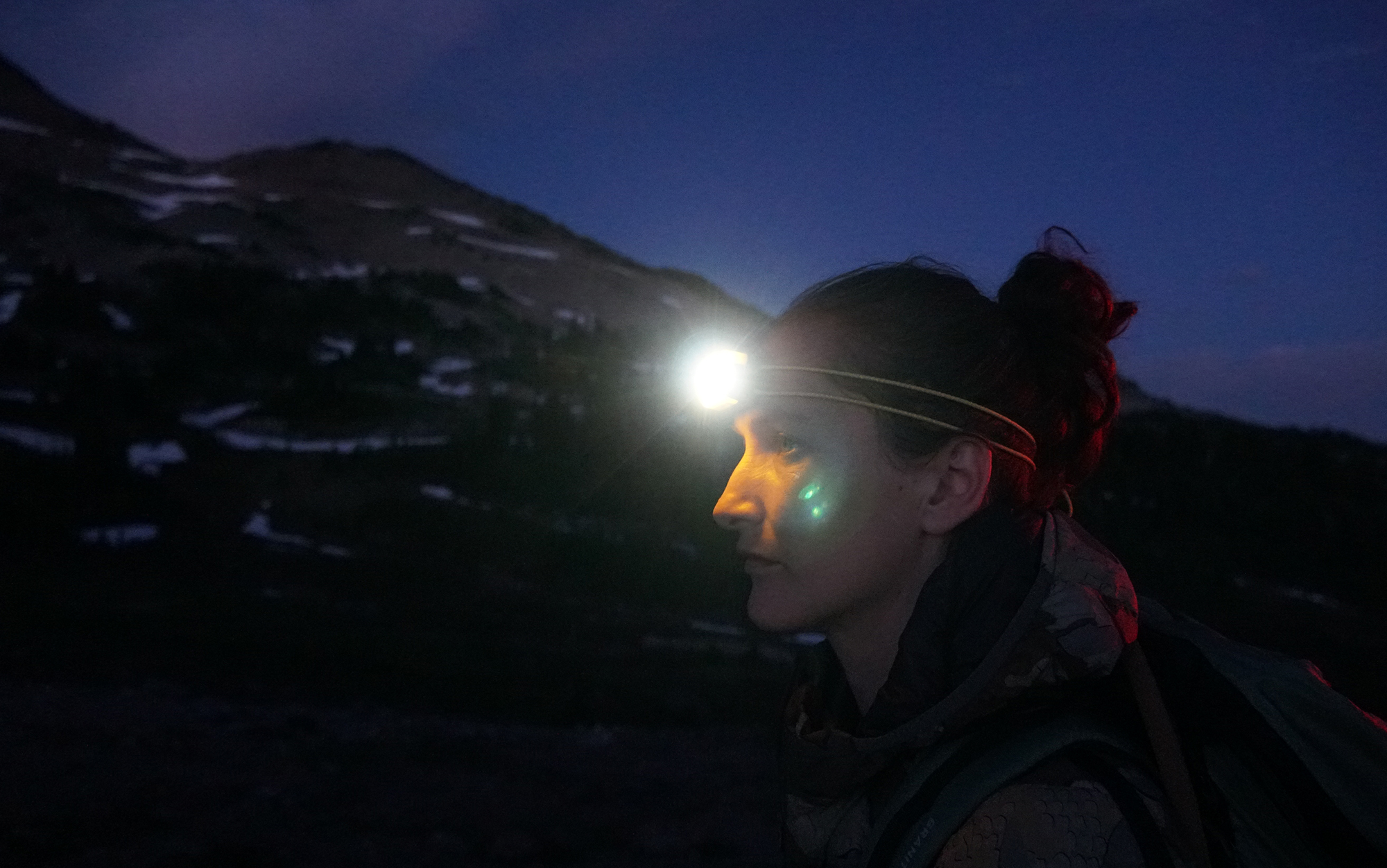
Alex Robinson
One button toggles which of the two lights are on, and the other button cycles brightness levels and red. Staff writer Laura Lancaster’s ideal headlamp would have one button for on, off, and red. While there’s two buttons on this lamp, it was still her favorite at the backpacking gear test, because of how simple it is to use, and its light weight. If you’re looking for something simple, affordable, and effective, this is the best headlamp for you. The Nitecore lasted almost 12 hours in my battery life test, too.
Best for Trail Running: Petzl Nao RL
Key Features
- Lumens: 1500
- Lights: Reactive and standard white
- Weight: 5.11 ounces
- Weather Resistance: IPX4
- Price: $180
- Warranty: 3 years
- Measured Battery Life: 2.5 hours on max brightness
- Rechargable
- Rear red light
Pros
- Wide, bright beam
- Lots of fit adjustments
- Comes with a storage pouch that doubles as a lantern
Cons
- Heavy
- Expensive
Not all headlamps are useful for trail running, in fact, most aren’t. This is because the super lightweight lamps are usually not bright enough and the heavier ones always seem to wobble and shift as you run. The bouncing beam will make you dizzy or you’ll have to constantly reposition the headlamp as you go.
So if you are going to be running at night regularly, I suggest spending the extra cash on a headlamp that was designed for the purpose. Meet Petzl Nao RL. You’ll see this headlamp being worn by the world’s top ultra-runners (like phenom Courtney Dauwalter), but you don’t have to be lining up at UTMB to appreciate its features. I wore the Nao RL for a few nighttime trail runs around my house (after years of experimenting with other inferior headlamps) and now I’ll never run at night without it.
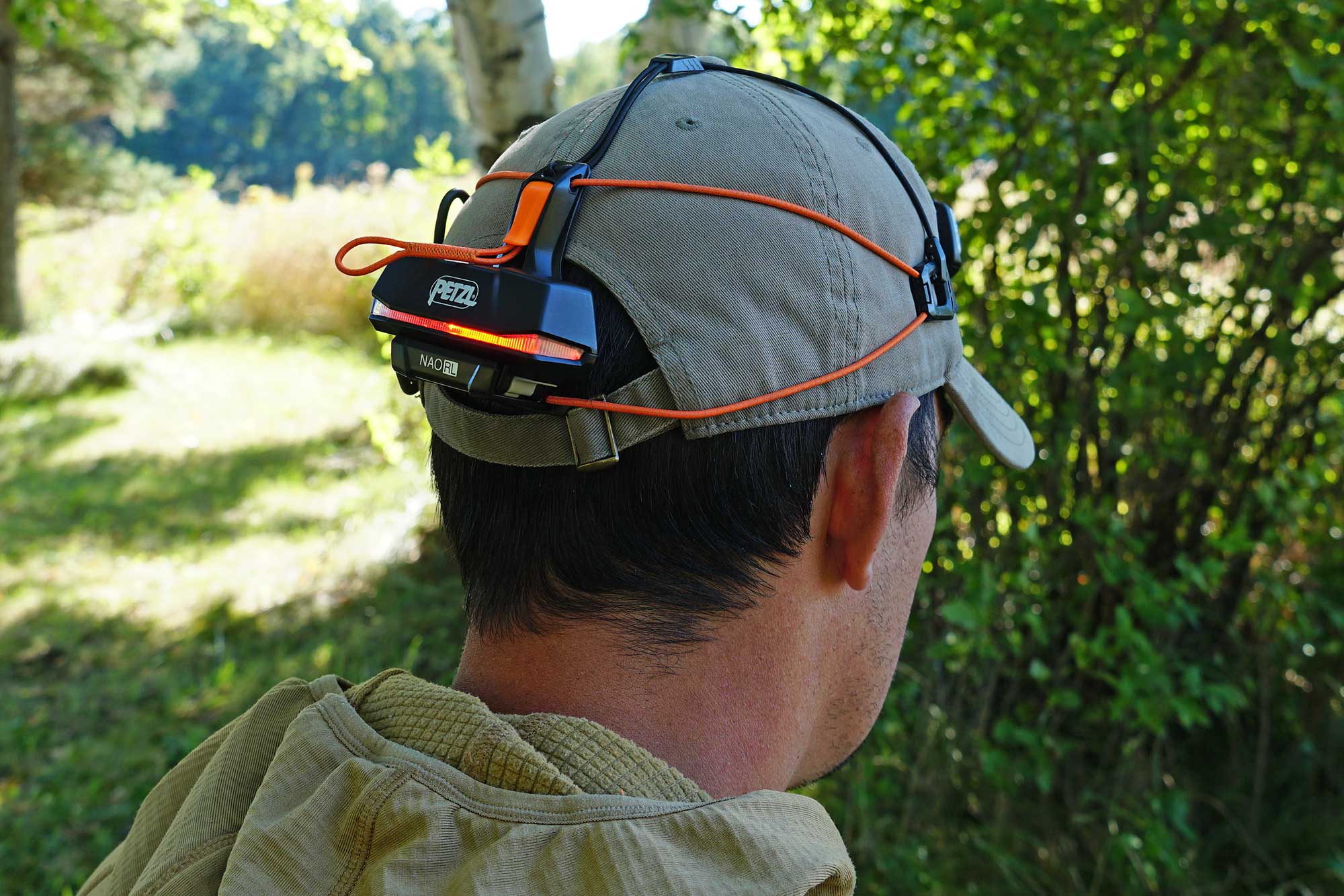
Photo by Alex Robinson
There are a few specifics that make the Nao RL an ideal headlamp for running. The first is fit. You’ll notice that the battery pack is in the back, this makes the weight more balanced and helps prevent the headlamp from moving out of place while running. Instead of a single strap, the Nao utilizes a harness system (with multiple adjustment points) for your head. It takes some tinkering to get it to fit properly, but when you do get it right, it will feel comfortable and stable no matter what type of running you do. Plus the lamp itself does not wiggle on the strap at all when you run.
This headlamp also has a reactive lighting mode. The light body has a sensor and accelerometer which work to automatically adjust the brightness of the beam depending on the distance of the objects around you, the amount of available ambient light, and the speed at which you’re traveling (faster means more light, slower means less light). There is of course a standard mode, which allows you to adjust brightness manually. However, the benefit of the reactive mode is that it preserves battery life by dimming the light at times when you don’t need full power.
While messing around in camp, reactive lighting mode was annoying to me. I just wanted a consistent beam. But while running, I didn’t even notice the feature, which is what you want. I settled on using the second brightness setting (out of three) in reactive mode for my runs, which seemed to be the perfect sweet spot of brightness and battery life (at least five hours). On max power, the battery only lasted 2.5 hours. So if you are a hardcore ultra-runner who will be trucking through an entire night, you should get a second rechargeable battery to keep in your vest.
Final features that I appreciated about this headlamp are the optional red light on the back (so cars can see you if you’re road running), the white carrying pouch which doubles as a lantern if you leave the lamp on, and you can lock the light off by holding the power button for four seconds. —Alex Robinson
Read Next: Best Running Vests
Best for Hiking: BioLite Headlamp 425
Key Features
- Lumens: 425
- Modes: Spot, flood, dimming, strobe, and red
- Weight: 2.75 ounces
- Weather Resistance: IPX4
- Price: $60
- Warranty: 1 year
- Measured Battery Life: 6 hours
- Rechargable
- Rear red light
Pros
- Dimmable red
- Slim profile
- Stable when running
Cons
- Difficult to tilt
- Must cycle through all settings to turn off
While a few companies are streamlining their headlamps with the battery in the back and just the light in the front, BioLite took this design to another level by also making the light incredibly thin, balancing the weight . It gives the front a slim profile and makes for a steady beam when running. This model has great proximity lighting for hiking, and it’s comfortable to wear. The battery lasted 6 hours in the burn time test.
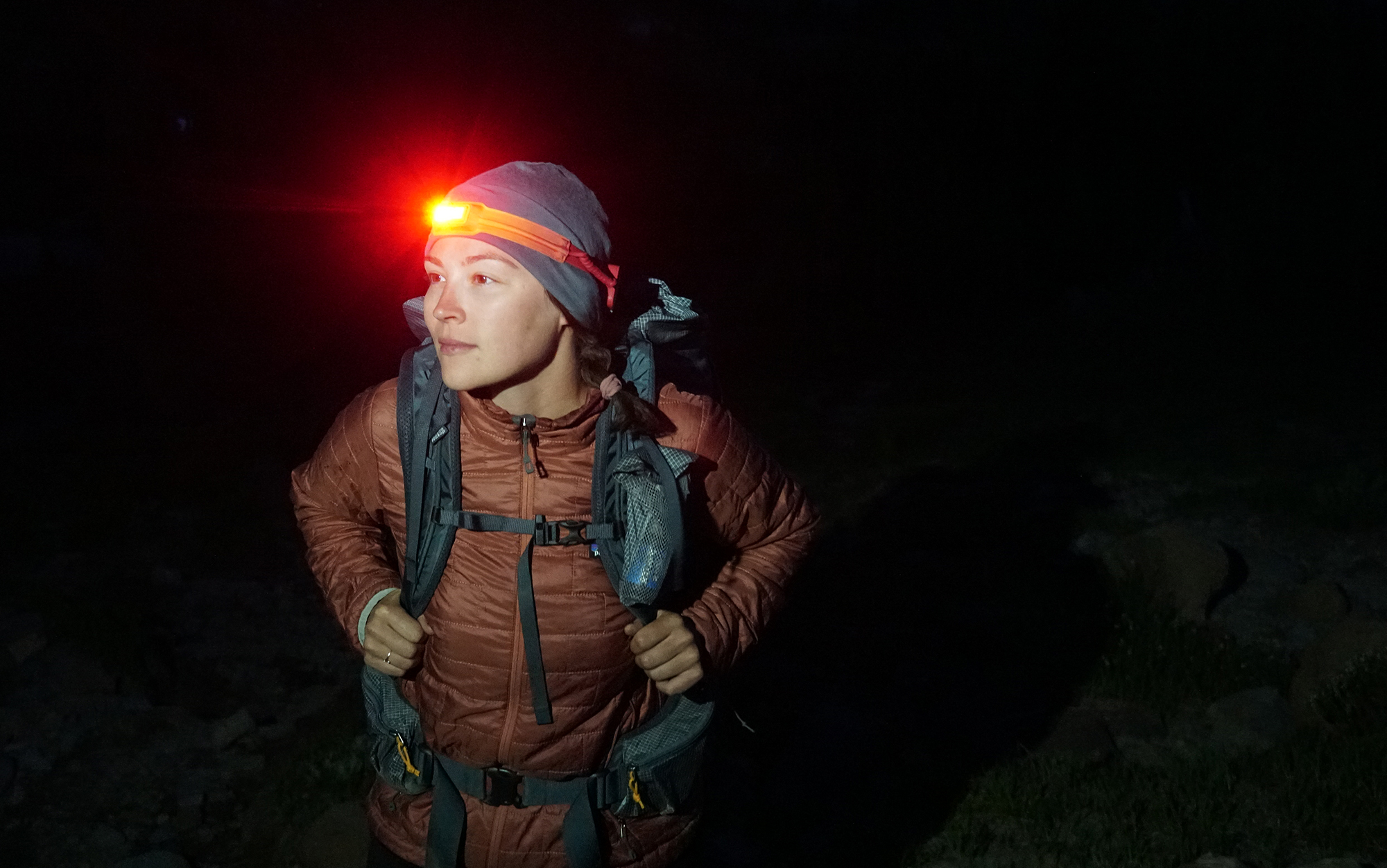
Alex Robinson
The stability and various brightness levels makes the BioLite 425 ideal for night hiking. I love that you can dim the red light to preserve your night vision. Overall it’s less packable thanks to the cord and two units on the band
I appreciate that BioLite is doing something unique with the design, but the light is difficult to tilt because it’s so skinny, and it’d be almost impossible with gloves on. You also have to cycle through all of the settings to turn this headlamp off, which means you’re subjected to the strobe feature every time.
Most Packable: Petzl Bindi
Key Features
- Lumens: 200
- Lights: Red and white (proximity, movement, and distance)
- Weight: 1.23 ounces
- Weather Resistance: IPX4
- Price: $50
- Warranty: 5 years (lamp), 2 years (battery)
- Measured Battery Life: 5 hours and 25 minutes
- Rechargable
Pros
- Compact
- Ultralight
- Easy to use
Cons
- Not very bright
This ultralight and packable headlamp is great for hiking and backpacking with just enough lumens to maneuver and no extra frills. My favorite thing about it though is that it’s almost impossible to accidentally kill your night vision. When you turn it on, either the red light or dimmest white light turns on first. Then you use one button to toggle through the other brightness settings or hold it down to switch colors. The cords don’t have to be very tight to your head for steady lighting, even when running, and the fit is comfortable.
The light spins 360 degrees in the housing to tilt in any direction. This is helpful when you hang the light around your neck and want to tilt it up. The housing can also act as a physical lock mode, covering the on button so it doesn’t turn on in your pack and waste battery.

Ashley Thess
The Bindi turned off after 5 hours and 25 minutes in my battery test. The white light output is just enough for night hiking, and plenty for moving around camp in the evening, but don’t plan on scanning a ridge line or spotting distant cairns in the dark with 200 lumens.
I like red lights to preserve my night vision, but the Bindi’s red is almost too subtle. I was able to cook with it, but moving around camp was difficult. Petzl may have had romantic ideas about naming their headlamp the Bindi, which can signify the point at which creation begins, enlightenment, and protection. But naming a headlamp with a red light in the middle after a culturally and religiously significant face decoration feels unnecessarily disrespectful.
Best for Camping: Petzl Aria 2
Key Features
- Lumens: 450
- Lights: White, red, green, and blue
- Weight: 3.8 ounces
- Weather Resistance: IP67
- Price: $60
- Warranty: 5 years
- Measured Battery Life: 16 hours
- Rechargeable battery sold separately
Pros
- Not initially blinding
- Red, green, and blue light
- Option to use rechargeable battery or AAAs
Cons
- Not very bright
- Cheap housing
The Aria 2 is my pick for camping thanks to the proximity lighting, multiple light colors, and hybrid battery. Most of the time you don’t need a sup-er-bright headlamp for camping, as most of your tasks will be close at hand.
The best way to describe the lighting is ambient, giving your surroundings a soft glow. There’s only one button, and it takes a couple minutes to figure out how to use it, but once you do it’s intuitive. The band is soft and thick to wear comfortably around your head or neck.
It always turns on at the lowest brightness, or the colored light you were using when you turned it off. The Aria 2 has red, green, and blue lights for preserving your night vision, and not blinding your campmates. Hold the button to change color, and click to cycle through the settings. Unfortunately you have to cycle through the highest white light setting to turn it off.
The housing is bulky and feels cheap. I always worry it isn’t closed all the way, but I threw water on it and dropped it on the floor to no detriment. When running, there is some movement, because the unit protrudes. After all, it needs space to hold three AAAs.
You can purchase a rechargeable battery separately which gives you the freedom to charge when you remember, and throw in some batteries when you forget or need more juice. I used disposable batteries in the burn life test and it died after 16 hours.
Best for Climbing: BioLite Headlamp 800 Pro
Key Features
- Lumens: 800
- Modes: Spot, flood, dimming, strobe, and red
- Weight: 5.3 ounces
- Weather Resistance: IPX4
- Price: $100
- Warranty: 1 year
- Measured Battery Life: 20 hours and 50 minutes
- Rechargeable
- Rear red light
Pros
- Large proximity lighting
- Stable when running
- Can connect to an external battery (3-foot cord included)
Cons
- Not the best distance lighting
The 800 Pro lights up the space around you well, but doesn’t cut through darkness over distance. As such, this is an excellent headlamp for climbing or canyoneering when you don’t need to see a long distance, just detail close by. The battery lasted an impressively long time, too, almost 21 hours.
It’s comfortable to wear because the battery is on the back, balancing the weight across your head. The band also also easily stays in place on a helmet. When it’s tight to your head, there’s no movement while running. Tilting this model is easier than BioLite’s 425 headlamp thanks to a space between the band and light housing to hook your finger into.
You have the option of using an included 3-foot cord to connect an external battery for long missions, or extreme cold weather where battery life can diminish. The ability to prolong the battery life with extra batteries means you always have extra juice to keep going at night.
Best for Mountaineering: Petzl Swift RL
Key Features
- Lumens: 1100
- Lights: Reactive lighting, standard lighting, red lighting, red strobe
- Weight: 3.53 ounces
- Weather Resistance: IPX4
- Price: $140
- Warranty: 5 years
- Measured Battery Life: 13 hours
- Rechargeable
Pros
- Bright light
- Headband can be detached and washed
- Option for reactive lighting
Cons
- Large unit
This headlamp has a piercing beam of light for searching the woods or seeing a long distance in the dark. The excellent lumens and relatively light weight make this a great headlamp for hunting, mountaineering, and night hiking.
You have the option to select reactive lighting which will adjust the beam according to how light your environment it is. I like that standard lighting is automatic, but you can turn on reactive lighting with a long hold. Most of the time I find reactive lighting is a pain, but it’s nice to have the option to prolong battery life. It lasted 13 hours in my battery test.
While lightweight and powerful, the unit is clunky, so it sticks out a bit allowing for some instability while running. But it’s easy to use and features a red light for preserving your night vision. Plus, when you get back to camp you can put the lamp in its white carrying case and hang it up to create a lantern effect.
Best 2,000 Lumen: Coast XPH34R
Key Features
- Lumens: 2,075
- Modes: Low, medium, high, and turbo
- Weight: 8 ounces
- Weather Resistance: IP54
- Price: $90
- Warranty: Lifetime
- Measured Battery Life: 24 hours
- Rechargeable or three AAA batteries
Pros
- Wide beam
- Hybrid battery
- Magnetic
Cons
- Clunky
Despite the Coast XPH34R’s whimsical name, this headlamp means business. I lent this light to a friend while we explored an abandoned mine. The wide, bright beam easily lit up pitch black offshoot tunnels and other levels above and below us. It also came in handy running back to the car down a steep, wooded trail at night. Utilizing the over head strap in conjunction with the headband, he was able to tighten it enough for a steady light, and not much jostling.
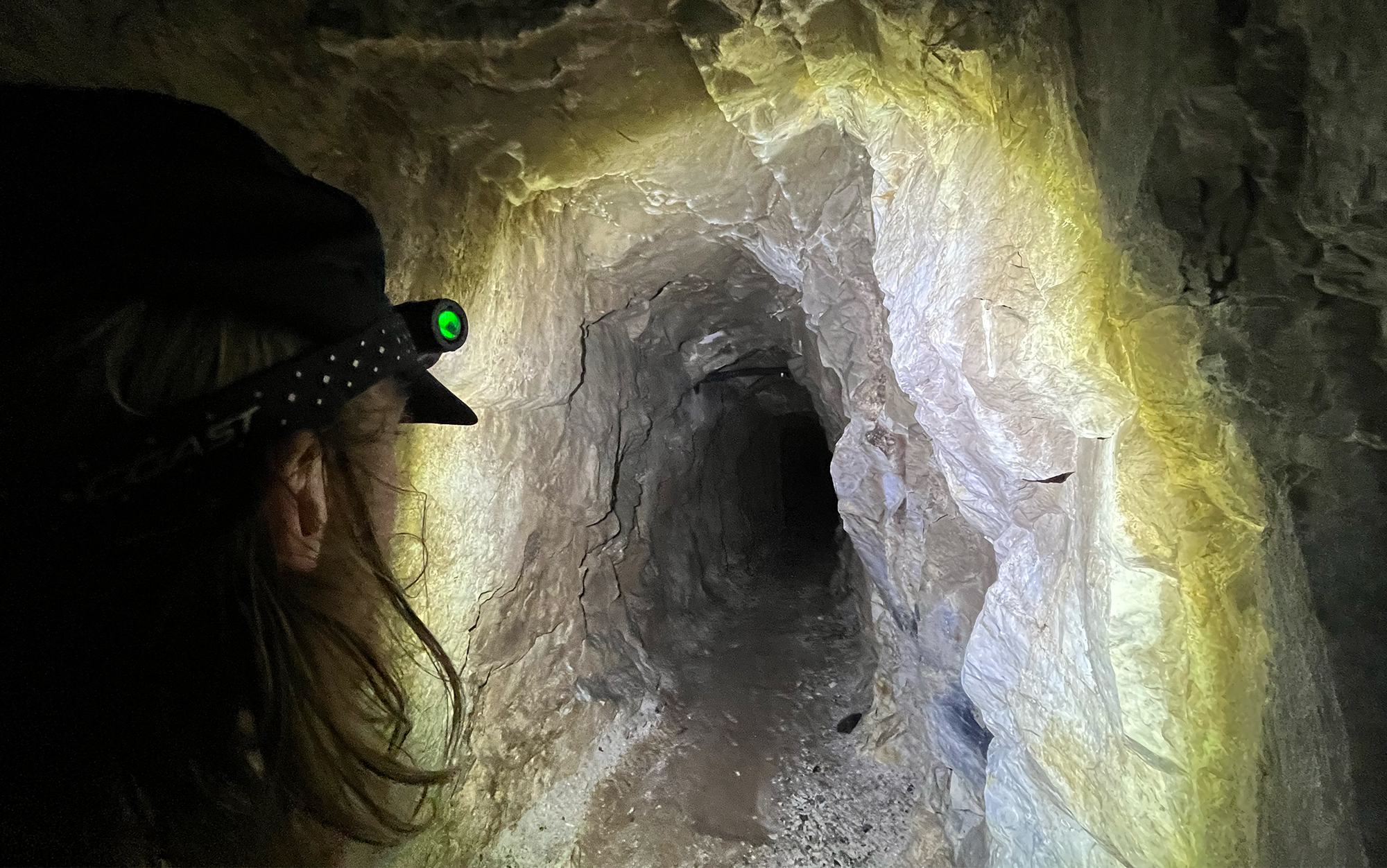
Ashley Thess
The end of the lamp is magnetic to mount over a project, and there’s a ring you can spin to focus your light beam. You can use the Coast XPH34R as a handheld light, too. It is bulky, but it has the capacity to hold three AA batteries or the rechargeable battery it comes with. This headlamp lasted the longest in my burn time test at 24 hours. The hybrid battery means you can prolong the burn time even further by subbing in alkaline batteries after the charge runs out.
While there are no other color modes, it makes the XPH34R easy to use. Every time you hit the power button, it simply turns off. And it always turns back on to the lowest setting so you aren’t blinded. Hold the button down to change settings. At 2,000 lumens, this headlamp is great for serious lighting needs like exploring dark spaces, performing more intricate tasks in the dark, and lighting up a long distance.
Best Bright Headlamp: Fenix HP30R V2.0
Key Features
- Lumens: 3,000
- Lights: White (flood and spotlight)
- Weight: 15.4 ounces
- Weather Resistance: IP66
- Price: $220
- Warranty: Limited lifetime
- Measured Battery Life: 3.5 hours
- Rechargeable
Pros
- Super bright
- Extremely simple to use
Cons
- Heavy
- Gets hot
This is the brightest and heaviest headlamp in our review. In fact when we first requested this headlamp from Fenix, they were hesitant to send it to us, as they make more practical models for camping and hiking. This one, they said, was more for industrial applications.
But sometimes an outdoorsman needs a bright-ass headlamp, like when you’re trying to blood track a deer at night, or in my case, running a river at zero dark thirty in my duck hunting boat. For these purposes the Fenix HP30R is ideal.

Photo by Alex Robinson
It has floodlight and spotlight modes each with multiple brightness settings. The turbo spotlight mode is what delivers the 3,000 lumens. The light functions as intuitively as any in our review. There is a simple knob on the right side of the lamp. Turn it up for floodlight mode and turn it down for spotlight mode. The more you turn, the brighter the light gets.
Now, there are headlamps on the market that offer more lumens, however buyer beware. Many of those headlamps are cheapo products of questionable quality. This Fenix headlamp is a more serious light.
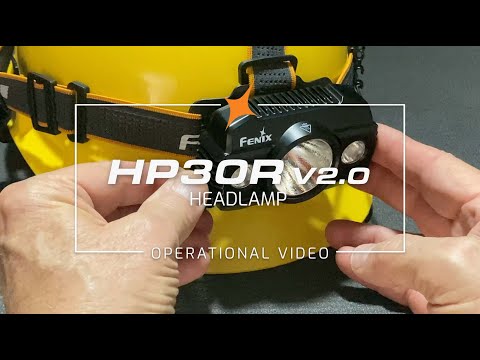
Of course, this headlamp is super heavy and it’s not exactly comfortable to wear for an extended period of time. I noticed that after an hour in turbo mode the light starts to get pretty warm so if you’re not wearing a hat you’ll probably end up with a sweaty forehead. And, at $220 it’s also the most expensive headlamp in our test. But, there is the price to pay for turning darkness into daylight. —Alex Robinson
Best Voice Control: Coast RL35R
Key Features
- Lumens: 1,100
- Modes: Arc, spot, flood, red, green, and blue
- Weight: 6.8 ounces
- Weather Resistance: IP54
- Price: $100
- Warranty: Lifetime
- Measured Battery Life: 3 hours
- Rechargeable
Pros
- Option for voice control
Cons
- First to die in battery test
Headlamps can be annoying to figure out, resulting in incessant clicking to find the setting you want. Coast created a voice controlled headlamp to simplify your life. Press a button on the bottom of the device to turn on the voice sensor and you can give commands addressing it as Coast (you don’t have to rattle off RL35R). It has the added benefit of allowing you to adjust your light hands-free, which is nice if your hands are full or messy, like while loading the car, cooking, or field dressing.
It responds to voice commands efficiently, though it can pick up on random words and attempt to adjust. Plus, it will respond to any voice so if you start annoying your friends by talking to your headlamp, they can talk to it, too. The voice control is a fun idea, but the brightness, battery life, and size leaves something to be desired.
The Coast RL35R was the first to die in my battery test after three hours, and at nearly 7 ounces, it’s bulky to wear. I won’t by relying on this headlamp in the backcountry, but it’s a great front country party trick to control your headlamp like an Alexa device. It also has a nice ambient light option that’s good for reading, and red, green, and blue light.
Nite Ize Radiant RH2
Key Features
- Lumens: 700
- Modes: Spot (low, high, blast) and flood (low, high, red, red flash)
- Weight: 2.65 ounces
- Weather Resistance: IPX7
- Price: $50
- Warranty: 2 years
- Measured Battery Life: 10 hours
- Rechargeable or three AAAs
Pros
- Hybrid battery
- Waterproof
Cons
- Charging cable not included
- Always accidentally turning on and wasting battery
The Nite Ize Radiant RH2 offers some peace of mind when it comes to weather resistance and battery life. I’ve seen people kill headlamps wading into a hot spring at night, falling during a stream crossing, etc. While most are just resistant to splashes or rain, the Radiant RH2 is submersible. It also has a hybrid battery capability, so if you forget to charge it, you can still get after it with some alkaline batteries. With the rechargeable battery it comes with, it burned for 10 hours, becoming dimmer after 3 hours.
If you’re looking for a low maintenance headlamp, the RH2 is ideal for camping, hiking, and any other low intensity activity. It is bulky and moves when running. The beam also has less reach than other headlamps in the same lumen class.
You should be wary that the RH2 is extremely likely to accidentally turn on in your pack and waste battery. You’ll want to initiate the lock function every time you stow it, so you don’t end up pulling out an already lit and dying headlamp.
Silva Explore 4
Key Features
- Lumens: 400
- Modes: Low, medium, high, orange, and red
- Weight: 3 ounces
- Weather Resistance: IPX7
- Price: $50
- Warranty: 2 years
- Measured Battery Life: 27 hours and 45 minutes
- Three AAA batteries or Silva Explore 4RC rechargeable version for $65
Pros
- Low mode is 10 lumens, great for reading
- Removable wide band
- Great battery life
Cons
- Turns on at highest setting
- Batteries are not included
- Gel inside headband tugs my hair
For high intensity activities, you need a headlamp that will stay in place and adjust to exactly where you need it. The Explore has a wide band with a thin gel line inside to keep it in place. You can twist the Explore completely up or down, with the ability to make minute adjustments. I love being able to angle the beam exactly where I want it, and have it stay there.
This headlamp was the second to last to die in my battery test. It took almost 28 hours to kill the three Duracell AAAs. Disposable batteries are almost always going to outlive rechargeables, but this headlamp wouldn’t quit. You’ll just have to buy those batteries separately.
The long battery life, streamlined housing, and effective headband make the Explore 4 great for running, exercising, and other fast paced endeavors. The Explore 4 doesn’t pack down very small, so it wouldn’t be my first choice for backpacking.
The gel on the band that keeps it in place does tug on my hair, but it keep the light mostly stable when running. It automatically turns on at the highest setting which can be annoying, but if you hold down the button you can access the pleasant red and orange modes.
Silva Trail Runner Free
Key Features
- Lumens: 400
- Modes: Low, medium, high, and strobe
- Weight: 4 ounces
- Weather Resistance: IPX5
- Price: $90
- Warranty: 2 years
- Measured Battery Life: 5 hours
- Rechargeable or three AAAs
- Rear red light
Pros
- Penetrating brightness
- Option to carry battery or mount to the back
- Hybrid battery
Cons
- Gel on band pulls my hair
- No red light
This tiny light surprised me; it seems to be milking every one of those 400 lumens. The beam is bright and cuts through the darkness, making it ideal for lighting long distances. If you’re looking for steady brightness, the Trail Runner free is a great option. You can streamline the band as well by carrying the hybrid battery pack in your pocket using the included cord. Or keep it mounted to the back of the extra thick band.
The lamp is stable when running, and the battery lasted 5 hours in the burn time test. This headlamp is versatile enough for most activities, though the thick band doesn’t lend itself to wearing around your neck. And the gel on the inside of the band did pull on my hair uncomfortably.
Black Diamond Distance
Key Features
- Lumens: 1,500
- Modes: Low, medium, high, and PowerTap
- Weight: 4.4 ounces
- Weather Resistance: IP67
- Measured Battery Life: 6 hours
- Price: $200
- Warranty: 3 years
Pros
- Impressively bright
- Waterproof
Cons
- Not stable when running
- No red light
This is the headlamp I used when walking through an abandoned mine and found it provided a ton of light. I also used it to run down a steep forested trail at night and was similarly pleased with how bright it was. The Distance is great for most endurance activities like alpine starts mountaineering, or skiing in the dark. I would also use it again to explore a cave or other dark space.

Ashley Thess
In my burn time test, this headlamp lasted for 6 hours, which is pretty good for how bright it is. It’s also waterproof and the weight is well balanced with the battery mounted at the back. If you need a lot of light in a performance package, this model from Black Diamond will serve you well. The light did move while running, though.
Things to Consider Before Buying the Best Headlamps
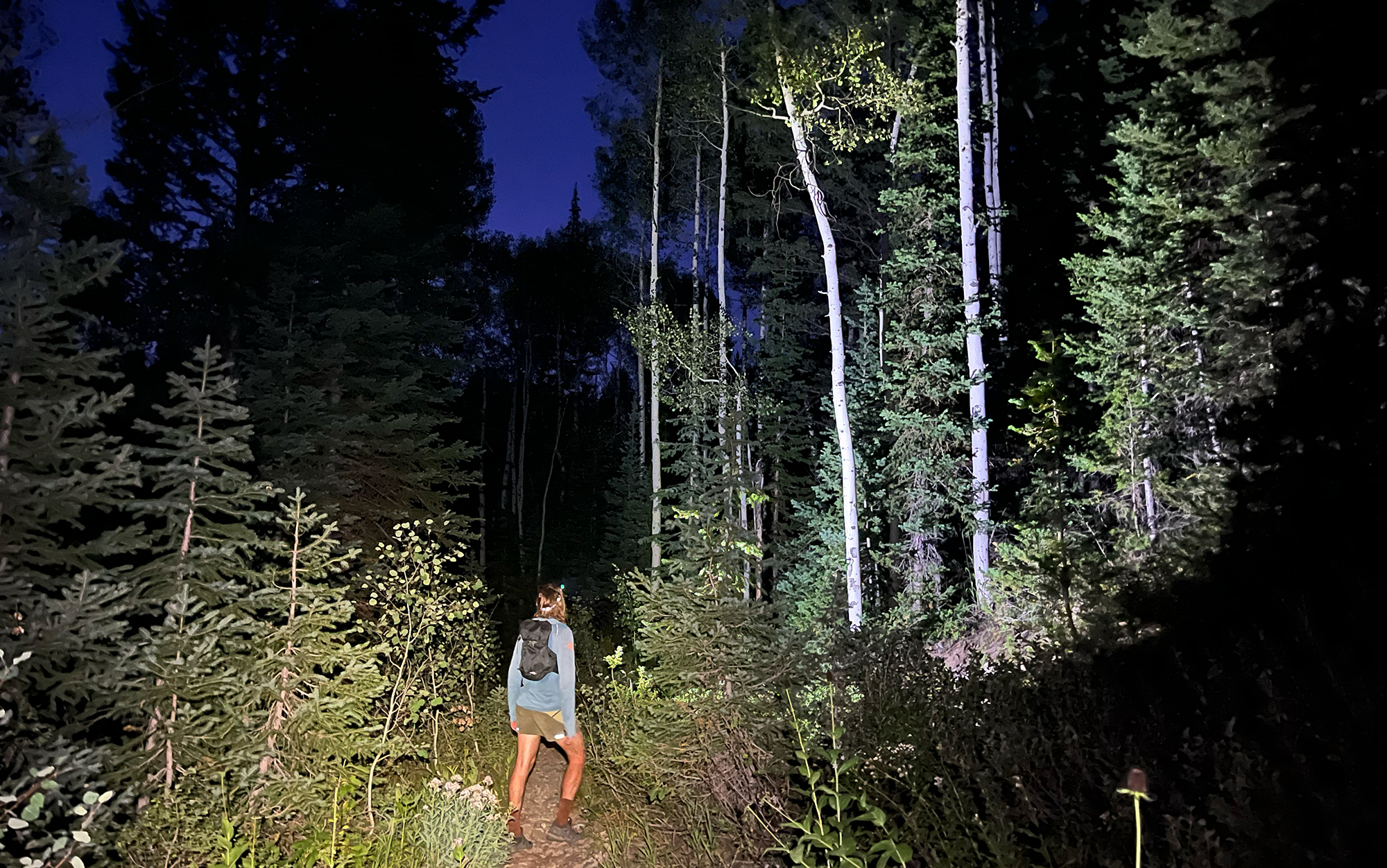
Ashley Thess
Maybe you see my struggle here; none of these headlamps are delivering on all fronts. While the Black Diamond models have the brightness and quality construction I’m looking for, I find their PowerTap feature annoying and they don’t stay steady while running. Petzl’s designs are smart but held back by the clunky housing. Coast and Silva are uncomfortable, but very bright. BioLite is at least trying something different, but cycling through all the brightness settings is a drag.
When it comes to finding the best headlamp, you’ll have to prioritize what features work best for you. In my testing, nothing stood out as the do-it-all best headlamp, but all of these models are doing something right. Take these major considerations into account.
Battery
Rechargeable batteries are better for the environment, and simple to use. But if you forget to charge your headlamp, you’re out of luck. Though, some rechargeable headlamps have the capability to hook up to another external battery. Headlamps that take alkaline batteries are always ready to go as long as you have batteries, and you can replace them in the field.
My favorite versions are the hybrids, capable of charging and taking batteries in case it isn’t charged or you need more juice.
Lumens
I separated the best headlamps into 200, 400, 500-800, and 1,000+ lumens to give you an idea which models are best for your lifestyle. If you only need minimal light for reading in your tent, going to the bathroom at night, or following a well-maintained trail, 200 is suitable. Four hundred lumens is a good middle ground to hunt for firewood, starting before dawn, and low-exposure scrambling. The higher range is optimal for adventurous hikers, campers, and trail runners. The 1,000+ models will give you greater distance visibility and cut through very dark spaces.
Settings
If you value preserving your night vision or don’t want to wake your campmates, colored lights are ideal. Red light will keep your natural night vision intact. Green and blue are a tad brighter for reading maps, and blue can help hunters follow a blood trail.
Final Thoughts on the Best Headlamps
While I’m still looking for the single perfect headlamp, there are tons of great quality options if you’re willing to pick and choose the features you value. The Black Diamond Storm-R is the best headlamp for all-around use thanks to its impressive lighting, multiple color modes, and waterproofing. If you need a simple headlamp that won’t break the bank, and comes in less than 2 ounces, you can’t go wrong with the Nitecore Nu25 UL.
- Best Overall: Black Diamond Storm R
- Best Value: Nitecore Nu25 UL
- Best for Trail Running: Petzl Nao RL
- Best for Hiking: BioLite Headlamp 425
- Most Packable: Petzl Bindi
- Best for Camping: Petzl Aria 2
- Best for Climbing: BioLite Headlamp 800 Pro
- Best for Mountaineering: Petzl Swift RL
- Best 2,000 Lumen: Coast XPH34R
- Brightest: Fenix HP30R V2.0
- Best Voice Control: Coast RL35R
- Nite Ize Radiant RH2
- Silva Explore 4
- Silva Trail Runner Free
- Black Diamond Distance
The post The Best Headlamps of 2024, Tested and Reviewed appeared first on Outdoor Life.
Source: https://www.outdoorlife.com/story/gear/best-headlamp/

